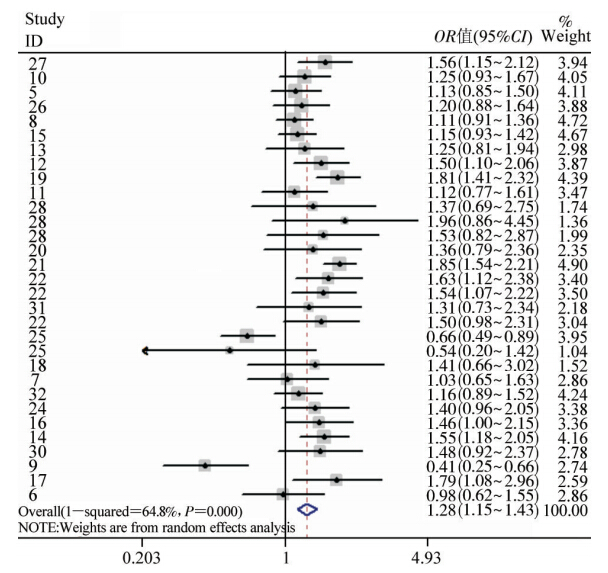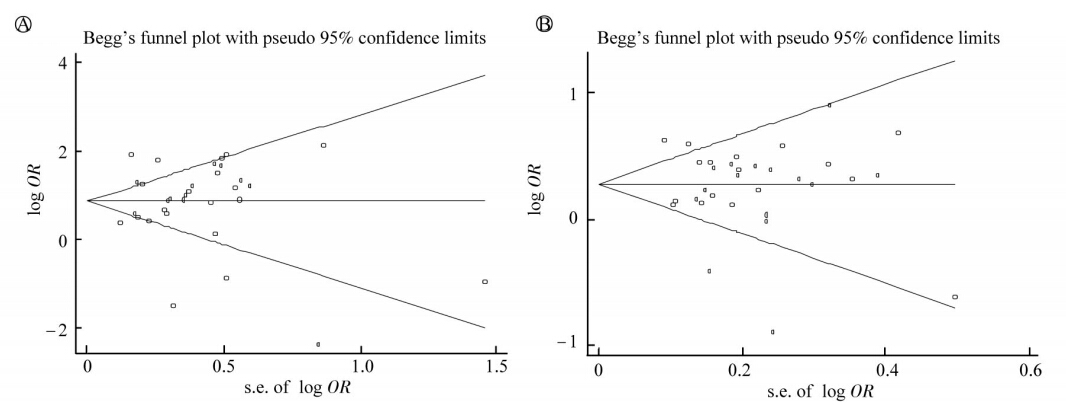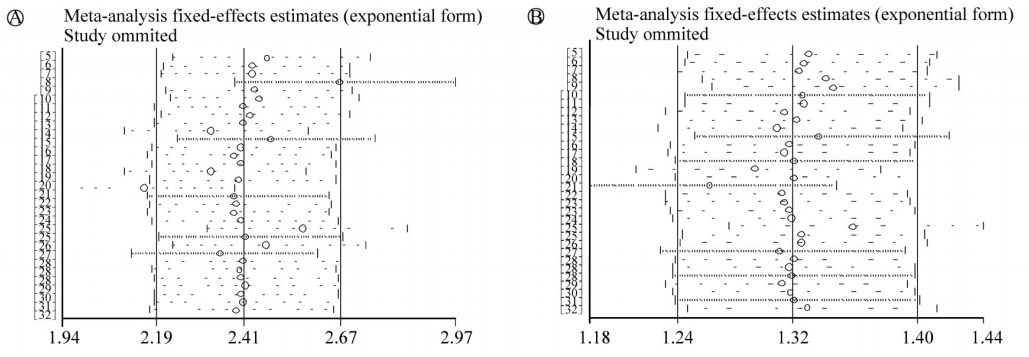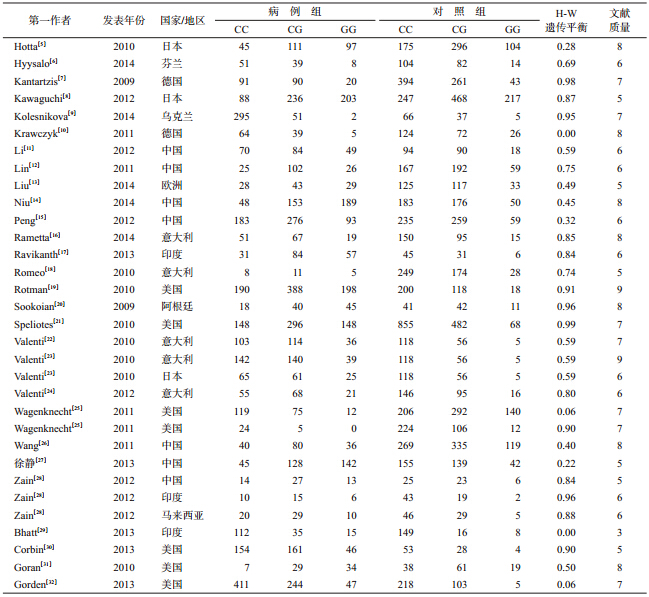文章信息
- 吴鹏波, 舒泳翔, 郭芳, 罗和生, 张国, 谭诗云. 2014.
- Wu Pengbo, Shu Yongxiang, Guo Fang, Luo Hesheng, Zhang Guo, Tan Shiyun. 2014.
- Patatin样磷酯酶结构域蛋白3基因rs738409位点多态性与非酒精性脂肪肝易感性关系的Meta分析
- Association between patatin-like phospholipase domain-containing protein 3 gene rs738409 polymorphism and non-alcoholic fatty liver disease susceptibility:a Meta-analysis
- 中华流行病学杂志, 2015, 36(1): 78-82
- Chinese Journal of Epidemiology, 2015, 36(1): 78-82
- http://dx.doi.org/10.3760/cma.j.issn.0254-6450.2015.01.018
-
文章历史
- 投稿日期:2014-08-26
2. 广西壮族自治区人民医院消化内科
2 Department of Gastroenterology, the People's Hospital of Guangxi Zhuang Autonomous Region
非酒精性脂肪肝病(NAFLD)是以肝脂肪变性和脂肪异常蓄积为主要病理特征的临床代谢综合征[1]。近年来NAFLD发病率明显上升[1,2,3]。Patatin样磷酯酶结构域蛋白3(PNPLA3)基因多态性与NAFLD的易感性近年来成为流行病学研究的焦点。但由于单个研究结论不一,现对已发表的相关研究进行Meta分析,以分析PNPLA3基因位点多态性与NAFLD之间的相关性。 资料与方法
1. 文献收集:计算机检索PubMed以及中文数据库(中国生物医学文献数据库、中国知网、万方数据库、维普数据库),检索时间为1990年6月至2014年7月。英 文 检 索 式:“non-alcoholic fatty liverdisease OR NAFLD”AND“mutation OR variant ORpolymORphism”AND“PNPLA3”;中文检索式:“非酒精性脂肪肝”和“基因多态性或突变”和“PNPLA3”。文种限中、英文,手工检索相关学术杂志。
2. 文献纳入和排除标准:纳入标准:①涉及PNPLA3基因rs738409多态性与NAFLD易感性相关的文献;②所有纳入研究均为公开发表的病例对照或巢式病例对照;③全文发表;④文献中数据完整,能直接或间接提供统计指标OR值及其95%CI;⑤病例均为经确诊NAFLD,其诊断符合影像学标准或者病理学标准。排除标准:①研究未设立对照组;②具体数据描述不清;③重复报道;④NAFLD相关的综述以及动物实验。
3. 资料提取和质量评价:由2名评价者独立根据纳入标准,对检索文献进行筛选,若存在意见分歧通过讨论达成一致。2名评阅人独立完成对原始文献信息收集。文献信息包括:第一作者姓名、出版年份、国家/地区、病例组对照组基因型分布及其频率。根据文献对纳入研究进行质量评价[4]。质量指标:①样本量是否充分;②病例诊断是否清楚;③病例组与对照组匹配情况;④对照组基因型分布是否符合Hardy-Weinberg(H-W)遗传平衡定律;⑤基因检测方法是否合理;⑥数据是否充分。6项指标每满足1项记为1分,其中总分≥3分者为质量可靠。
4. 统计学方法:采用Stata12.0软件进行Meta分析。采用X2检验分析各研究结果间的异质性;各研究结果间的异质性检验采用Q检验和P统计量,P<0.05为各研究间存在异质性,I2用以衡量异质性大小程度,若各研究结果间不存在异质性,合并采用固定效应模型计算OR值;反之采用随机效应模型合并效应OR值,P<0.05为差异有统计学意义。敏感性分析为依次排除单个文献后重新进行Meta分析,观察合并效应是否改变,Begger、Egger检测森林图对称性以判断是否存在发表偏倚。 结 果
1. 文献检索:根据中英文检索式初检出文献643篇,经阅读文题和摘要初筛,排除不符合文献433篇,进一步查找和阅读全文复筛,排除文献182篇,最终纳入28篇文献[5,6,7,8,9,10,11,12,13,14,15,16,17,18,19,20,21,22,23,24,25,26,27,28,29,30,31,32] (图 1)。所有纳入研究均为病例对照研究。纳入研究的基本特征见表 1。共纳入14434例,其中NAFLD患者病例数6216例,对照组8218例。CC、CG、GG基因型在病例组和对照组的分布分别为36.19%、42.88%、20.91%和48.70%、40.39%、10.91%。纳入的研究时间2009-2014年。除文献[29]外其他文献质量评分均>5分,提示文献质量较好。文献对照度不符合H-W遗传平衡定律,考虑敏感性分析,最终纳入32项病例对照研究。
 |
| 图 1 文献纳入过程 |
2. Meta 分 析:PNPLA3基 因 位 点 多 态 性 与NAFLD易感性Meta分析结果显示,纯合子比较模型(GG vs. CC):OR=2.42,95% CI:1.83~3.21,P<0.001;杂合子比较模型(CG vs. CC):OR=1.28,95% CI:1.15~1.43,P<0.001(图 2);显性遗传模型(CG+GG vs. CC):OR=1.31,95% CI:1.17~1.46,P<0.001;隐性遗传模型(GG vs.CC+GC):OR=2.26,95% CI:1.76~2.90,P<0.001;亚组分析显示,亚洲以及高加索人群PNPLA3基因rs738409位点多态性与NAFLD易感性亦明显关联(表 2)。
 |
| 图 2 总人群PNPLA3基因位点多态性与NAFLD易感性Meta分析CG vs. CC模型森林图 |
3. 发表偏倚分析:在总体人群中4种基因模型Meta分析漏斗图经Begger检验以及Egger检验显示,P>0.5,提示漏斗图对称、无发表偏倚存在。亚组分析显示,在亚洲人群中CG vs.CC以及GG vs. CC+GC模型Egger检验显示,均P<0.05(图 3),提示漏斗图可能不对称、存在发表偏倚。高加索人群分析无发表偏倚。
 |
图 3 PNPLA3基因位点多态性与NAFLD易感性Meta分析CG vs. CC ( )以及GG vs. CC+GC( )以及GG vs. CC+GC( )发表偏倚 )发表偏倚 |
4.敏感性分析:依次单独剔除1篇文献后,各基因模型Meta分析结果未见明显改变,提示结果稳定(图 4)。
 |
图 4 PNPLA3基因位点多态性与NAFLD易感性Meta分析CG vs. CC ( )以及GG vs.CC+GC( )以及GG vs.CC+GC( )敏感性分析 )敏感性分析 |
PNPLA3基因位于22q13.31,编码含有481个氨基酸组成的功能未知的非分泌性蛋白,该蛋白属于马铃薯贮藏蛋白样磷脂酶家族[33]。研究表明人类组织中,PNPLA3主要表达在肝脏,其次为皮肤和脂肪细胞。但该蛋白的生物学功能尚不十分清楚,与PNPLA3最为类似的结构体PNPLA2已被证实具有三酰甘油水解酶和酰基甘油转酰基酶活性[34]。
在发展中国家对NAFLD研究已成为消化内科医生关注的一个热点。近年来,随着人们生活水平的日益提高,NAFLD发病率逐渐升高,少数患者进展成肝硬化甚至肝癌。因而明确NAFLD的发病机制,以期找到NAFLD治疗的切入点和拓宽药物开发思路。目前,国内外很多研究证实PNPLA3基因突变与NAFLD发病密切相关,本研究通过Meta分析显示,PNPLA3基因rs738409多态性与NAFLD易感性有明显关联性。Meta分析异质性检验显示,PNPLA3基因rs738409点的各研究之间异质性较大,异质性的产生原因较多,其中研究人群遗传背景不同是造成基因多态性与疾病关联性分析研究之间异质性的重要来源之一;本研究根据研究人群遗传背景进行亚组分析,发现多数基因模型各研究之间异质性未明显减少,提示遗传背景不同不是异质性的主要来源。此外,Meta分析显示,无明显发表偏倚,敏感性分析结果稳定,提示该Meta分析结果科学可靠。
本研究表明PNPLA3基因多态性与NAFLD发病密切相关,然而其机制尚不明了,有待相关研究进一步验证[18,23,35]。我国学者徐静等[27]的研究显示,不同rs738409基因型胰岛素抵抗明显有差别,通过分析上述研究发现PNPLA3基因rs738409多态性可能是通过影响肝脏炎症以及机体胰岛素抵抗等方面影响NAFLD易感性。
本研究存在不足:只检索了国内外几个代表性数据库,检索语言仅为中文和英文,且只限于公开发表的文献,影响了纳入研究的全面性。纳入研究的人群无法分清民族。饮食和社会环境是影响NAFLD易感性的重要因素,本研究纳入病例-健康对照组的研究往往忽略上述因素。为进一步明确PNPLA3基因rs738409多态性与NAFLD易感性的内在联系,尚需要开展更大样本量、设计更严谨的研究。
| [1] Adams LA, Angulo P. Recent concepts in non-alcoholic fatty liver disease[J]. Diabet Med, 2005, 22:1129-1133. |
| [2] McCullough AJ. The clinical features, diagnosis and natural history of nonalcoholic fatty liver disease[J]. Clin Liver Dis, 2004, 8:521-533. |
| [3] Fan JG, Farrell GC. Epidemiology of non-alcoholic fatty liver disease in China[J]. J Hepatol, 2009, 50:204-210. |
| [4] Little J, Higgins JP, Ioannidis JP, et al. Strengthening the reporting of genetic association studies(STREGA):an extension of the STROBE statement[J]. Eur J Epidemiol, 2009, 24(1):37-55. |
| [5] Hotta K, Yoneda M, Hyogo H, et al. Association of the rs738409 polymorphism in PNPLA3 with liver damage and the development of nonalcoholic fatty liver disease[J]. BMC Med Genet, 2010, 11:172. |
| [6] Hyysalo J, Gopalacharyulu P, Bian H, et al. Circulating triacylglycerol signatures in nonalcoholic fatty liver disease associated with the I148M variant in PNPLA3 and with obesity[J]. Diabetes, 2014, 63(1):312-322. |
| [7] Kantartzis K, Peter A, Machicao F, et al. Dissociation between fatty liver and insulin resistance in humans carrying a variant of the patatin-like phospholipase 3 gene[J]. Diabetes, 2009, 58(11):2616-2623. |
| [8] Kawaguchi T, Sumida Y, Umemura A, et al. Genetic polymorphisms of the human PNPLA3 gene are strongly associated with severity of non-alcoholic fatty liver disease in Japanese[J]. PLoS One, 2012, 7(6):e38322. |
| [9] Kolesnikova O, Nemtsova V. P408 Effects of PNPLA3 polymorphisms on the progression of non-alcoholic fatty liver disease [J]. J Hepatol, 2014, 60 Suppl 1:S204. |
| [10] Krawczyk M, Grunhage F, Zimmer V, et al. Variant adiponutrin (PNPLA3) represents a common fibrosis risk gene:non-invasive elastography-based study in chronic liver disease[J]. J Hepatol, 2011, 55(2):299-306. |
| [11] Li Y, Xing C, Tian Z, et al. Genetic variant I148M in PNPLA3 is associated with the ultrasonography-determined steatosis degree in a Chinese population[J]. BMC Med Genet, 2012, 13:113. |
| [12] Lin YC, Chang PF, Hu FC, et al. A common variant in the PNPLA3 gene is a risk factor for non-alcoholic fatty liver disease in obese Taiwanese children[J]. J Pediatr, 2011, 158(5):740-744. |
| [13] Liu YL, Patman GL, Leathart JB, et al. Carriage of the PNPLA3 rs738409 C>G polymorphism confers an increased risk of non-alcoholic fatty liver disease associated hepatocellular carcinoma[J]. J Hepatol, 2014, 61(1):75-81. |
| [14] Niu TH, Jiang M, Xin YN, et al. Lack of association between apolipoprotein C3 gene polymorphisms and risk of nonalcoholic fatty liver disease in a Chinese Han population[J]. World J Gastroenterol, 2014, 20(13):3655-3662. |
| [15] Peng XE, Wu YL, Lin SW, et al. Genetic variants in PNPLA3 and risk of non-alcoholic fatty liver disease in a han Chinese population[J]. PLoS One, 2012, 7(11):e50256. |
| [16] Rametta R, Ruscica M, Dongiovanni P, et al. Hepatic steatosis and PNPLA3 I148M variant are associated with serum Fetuin-A independently of insulin resistance[J]. Eur J Clin Invest, 2014, 44(7):627-633. |
| [17] Ravikanth VV, Mitnala S, Avanthi US, et al. PNPLA3 gene polymorphism but not APOC3 enhances risk for nonalcoholic fatty liver disease in Indian subjects[J]. J Clin Exp Hepatol, 2013, 3 Suppl 1:S24. |
| [18] Romeo S, Sentinelli F, Cambuli VM, et al. The 148M allele of the PNPLA3 gene is associated with indices of liver damage early in life[J]. J Hepatol, 2010, 53(2):335-338. |
| [19] Rotman Y, Koh C, Zmuda JM, et al. The association of genetic variability in patatin-like phospholipase domain-containing protein 3 (PNPLA3) with histological severity of nonalcoholic fatty liver disease[J]. Hepatology, 2010, 52(3):894-903. |
| [20] Sookoian S, Castano GO, Burgueno AL, et al. A nonsynonymous gene variant in the adiponutrin gene is associated with nonalcoholic fatty liver disease severity[J]. J Lipid Res, 2009, 50(10):2111-2116. |
| [21] Speliotes EK, Butler JL, Palmer CD, et al. PNPLA3 variants specifically confer increased risk for histologic nonalcoholic fatty liver disease but not metabolic disease[J]. Hepatology, 2010, 52(3):904-912. |
| [22] Valenti L, Alisi A, Galmozzi E, et al. I148M patatin-like phospholipase domain-containing 3 gene variant and severity of pediatric nonalcoholic fatty liver disease[J]. Hepatology, 2010, 52(4):1274-1280. |
| [23] Valenti L, Al-Serri A, Daly AK, et al. Homozygosity for the patatin-like phospholipase-3/adiponutrin I148M polymorphism influences liver fibrosis in patients with nonalcoholic fatty liver disease[J]. Hepatology, 2010, 51(4):1209-1217. |
| [24] Valenti L, Rametta R, Ruscica M, et al. The I148M PNPLA3 polymorphism influences serum adiponectin in patients with fatty liver and healthy controls[J]. BMC Gastroenterol, 2012, 12:111. |
| [25] Wagenknecht LE, Palmer ND, Bowden DW, et al. Association of PNPLA3 with non-alcoholic fatty liver disease in a minority cohort:the insulin resistance atherosclerosis family study[J]. Liver Int, 2011, 31(3):412-416. |
| [26] Wang CW, Lin HY, Shin SJ, et al. The PNPLA3 I148M polymorphism is associated with insulin resistance and nonalcoholic fatty liver disease in a normoglycaemic population[J]. Liver Int, 2011, 31(9):1326-1331. |
| [27] Xu J, Xin YN, Lyu WH, et al. Polymorphism rs738409 in PNPLA3 is associated with inherited susceptibility to non-alcoholic fatty liver disease[J]. Chin J Hepatol, 2013, 21(8):619-623. (in Chinese)徐静, 辛永宁, 吕维红, 等. PNPLA3 rs738409基因多态性与非酒精性脂肪性肝病遗传易感性的关系[J]. 中华肝脏病杂志, 2013, 21(8):619-623. |
| [28] Zain SM, Mohamed R, Mahadeva S, et al. A multi-ethnic study of a PNPLA3 gene variant and its association with disease severity in non-alcoholic fatty liver disease[J]. Hum Genet, 2012, 131(7):1145-1152. |
| [29] Bhatt SP, Nigam P, Misra A, et al. Genetic variation in the patatin- like phospholipase domain-containing protein-3(PNPLA-3) gene in Asian Indians with nonalcoholic fatty liver disease[J]. Metab Syndr Relat Disord, 2013, 11(5):329-335. |
| [30] Corbin KD, Abdelmalek MF, Spencer MD, et al. Genetic signatures in choline and 1-carbon metabolism are associated with the severity of hepatic steatosis[J]. FASEB J, 2013, 27(4):1674-1689. |
| [31] Goran MI, Walker R, Le KA, et al. Effects of PNPLA3 on liver fat and metabolic profile in Hispanic children and adolescents[J]. Diabetes, 2010, 59(12):3127-3130. |
| [32] Gorden A, Yang R, Yerges-Armstrong LM, et al. Genetic variation at NCAN locus is associated with inflammation and fibrosis in non-alcoholic fatty liver disease in morbid obesity[J]. Hum Hered, 2013, 75(1):34-43. |
| [33] Baulande S, Lasnier F, Lucas M, et al. Adiponutrin, transmembrane protein corresponding to a novel dietary- and obesity-linked mRNA specifically expressed in the adipose lineage[J]. J Biol Chem, 2001, 276:33336-33344. |
| [34] Jenkins CM, Mancuso DJ, Yan W, et al. Identification, cloning, expression, and purifi cation of three novel human calcium- independent phospholipase A2 family members possessing triacylglycerol lipase and acylglycerol transacylase activities[J]. J Biol Chem, 2004, 279:48968-48975. |
| [35] Yuan X, Waterworth D, Perry G, et al. Population-based genomewidc association studies reveal six loci influencing plasma levels of liver enzynles[J]. Am J Hum Genet, 2008, 83:520-528. |
 2015, Vol. 36
2015, Vol. 36




